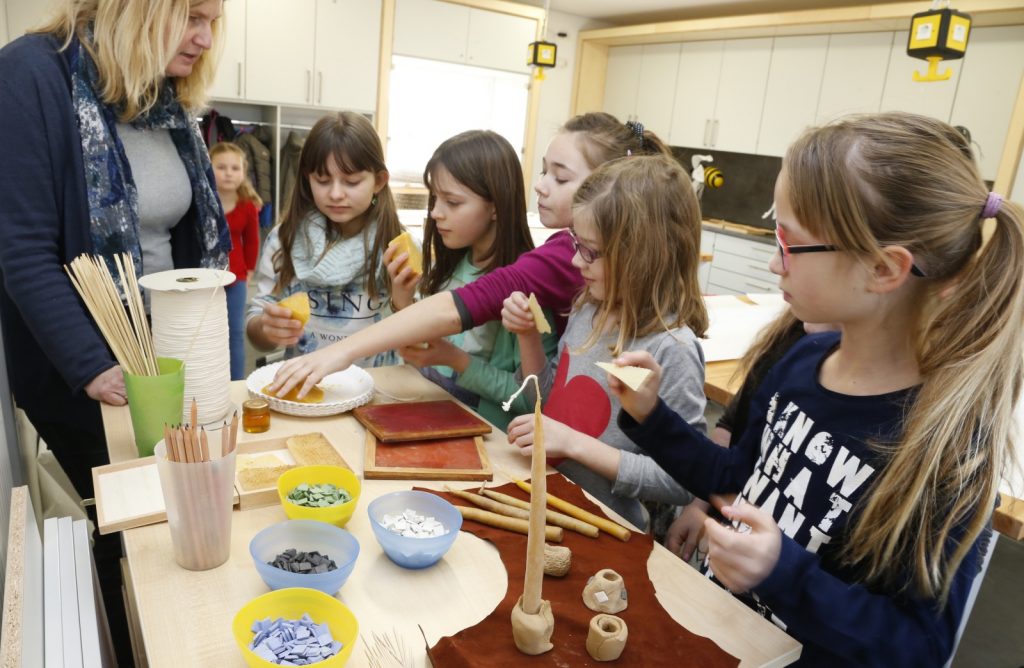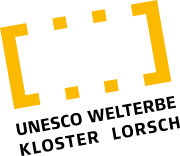
MUSEUM EDUCATION
Museum educational goals
Hands-on history is the aim of our museum and world heritage education. But it’s not just touching historical objects that opens up access to history, but perhaps even more so trying them out for yourself!
One thing is certain, the work steps and techniques of the Middle Ages required time and skill. That’s why we’re making things easier today, that’s for sure: We’re recreating the painstaking work of an ivory carver with the help of curd soap and the stamps for the artistic motifs on the clay floor tiles are not carved, but made from wood and foam rubber. Things get really “real” again when we make ointments and cough medicines according to the recipes handed down in the Lorsch Pharmacopoeia and make candles from real beeswax.

Wherever possible, we use authentic materials. Our educational museum activities always have a practical part where you can try something out.
Lauresham educational concept
In terms of educational work, the Lauresham open-air laboratory in particular fulfills several functions within the overall didactic concept of the Lorsch Abbey World Heritage Site. On the one hand, it provides a multifaceted insight into the reality of life in the Early Middle Ages and thus brings the topic of everyday culture in that time more into focus. This is where the advantages of a 1:1 model become very clear. This concept allows a very direct and lively approach to topics such as house building, home comfort, crafts, animal husbandry, agriculture and luxury. In a simple and playful way, it succeeds in rethinking prevailing clichés about the supposedly “dark Middle Ages” and showing that the foundations of the most diverse aspects of the present day were laid in this era.

On the other hand, Lauresham provides access to the topic of manorial rule, which is central to understanding the early medieval monastery of Lorsch. This is because the otherwise rather abstract concepts of order and organizational patterns can be illustrated quite vividly here using a manorial estate within a manor.
In the context of the didactic concept, Lauresham should therefore also be understood as the center of a small manorial association with the central courtyard as the center of life of a family of the early medieval upper class(nobilitas). These included unfree servants(servi, mancipia), but a manor was also regarded as a collection point for levies from estates, some of which were located far away. The different houses represented in the open-air laboratory are therefore not only intended to illustrate the economic complexity of the manorial system, but also to reveal the social structure reflected in it. For this reason, the simple residential and farm buildings of the peasant families are contrasted with the luxuriously furnished manor house.
The Lauresham concept also provides an impression of monastic land ownership. Many landlords donated their possessions to the saints of the monasteries out of concern for their salvation. This is how Lorsch Abbey, for example, came to extend its dominion from the Dutch North Sea coast to the Swiss Grisons. Such manor houses as (the fictitious) Lauresham could often take on important functions within the system of levies and servitude of an ecclesiastical community.
Last but not least, the didactic implementation of Lauresham also allows a more direct approach to the subject of faith and the church, which is not always easy due to the fragmentary character of the monastery complex on site. The (re)constructed chapel also plays a special role here. It is the only stone building on the open-air site where architectural sculpture and furnishings can be shown in a coherent context. Lauresham therefore also fulfills the special task of learning to better understand Lorsch Abbey, which is now largely destroyed. Even the gatehouse is easier to imagine on the basis of the Lauresham chapel, as the angle of the chapel’s roof pitch corresponds exactly to that of the Carolingian gatehouse, which has now been altered by the Gothic barrel vault.



